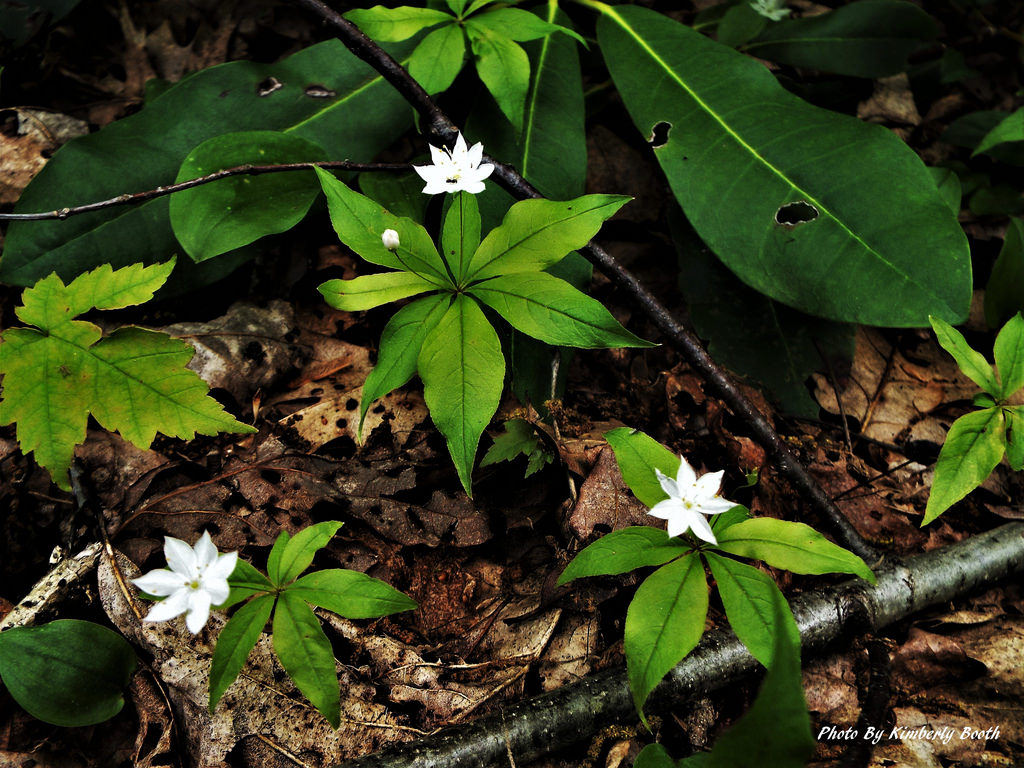Map Snapshot



55 Records
Seasonality Snapshot
Source: Wikipedia
| Lysimachia borealis | |
|---|---|

| |
| Scientific classification | |
| Kingdom: | Plantae |
| Clade: | Tracheophytes |
| Clade: | Angiosperms |
| Clade: | Eudicots |
| Clade: | Asterids |
| Order: | Ericales |
| Family: | Primulaceae |
| Genus: | Lysimachia |
| Species: | L. borealis
|
| Binomial name | |
| Lysimachia borealis (Raf.) U.Manns & Anderb.
| |
| Synonyms[3] | |
| |
Lysimachia borealis (synonym Trientalis borealis), the starflower, is a North American woodland perennial that blooms between May and June.[4][5]
Description
[edit]
Starflowers have creeping rhizomes with 5–20 cm (2.0–7.9 in) vertical stalks. Each stalk has a whorl of 5–10 lanceolate leaves (up to 8 centimetres or 3.1 inches long) at its tip, with one to four (most often one or two) white flowers on smaller stalks extending from the center of the whorl. The flowers are about 15 mm (1⁄2 in) across and consist of five to nine petals that form a star-like shape. Its fruit is tiny, globe-shaped, pale blue, and matte.[6][7]
Biology
[edit]Lysimachia borealis has three, fairly discrete phases of the life cycle each year: shoot development, rhizome growth, and tuber formation.[8] The species reproduces both sexually, by seed, and asexually, via tubers.[8] Flowers are pollinated primarily by halictid and andrenid bees.[9] In response to warming, L. borealis appears to shift reproductive effort away from sexual reproduction toward asexual vegetative spread.[10]
The species may show evidence for local adaptation, as northern and southern populations display differences in the timing of initiation of shoot growth and in the response of seeds to cold stratification.[8]
Starflower is a larval host for the weevil Pelenomus sulcicollis.[11]
Distribution and habitat
[edit]Lysimachia borealis is found from Canada to north-central and eastern United States, primarily in boreal forest in Canada and in northern conifer-hardwood forests in the United States.[8] It is found in temperate climates.[12] The species is one of the ten most common herbaceous-layer native plants in eastern deciduous U.S. National Park forests. The Lysimachia Latifolia, (Pacific Starflower) which is a pinkish, purple variety, is native to the west coast of the United States and parts of western Canada. [13]
Taxonomy
[edit]Two subspecies are recognized by the U.S. Department of Agriculture:
- Trientalis borealis Raf. ssp. borealis[14]
- Trientalis borealis Raf. ssp. latifolia (Hook.) Hultén – broadleaf starflower[15]
Conservation status
[edit]Lysimachia borealis is considered to be of "least concern" overall according to the International Union for Conservation of Nature.[1] As of 2017, L. borealis is listed as endangered by Georgia and Kentucky and as threatened by Illinois and Tennessee.[16]
References
[edit]- ^ a b Maiz-Tome, L. (2016). "Trientalis borealis". IUCN Red List of Threatened Species. 2016: e.T64326168A67731147. doi:10.2305/IUCN.UK.2016-1.RLTS.T64326168A67731147.en. Retrieved 19 December 2023.
- ^ NatureServe (1 December 2023). "Trientalis borealis". NatureServe Network Biodiversity Location Data accessed through NatureServe Explorer. Arlington, Virginia: NatureServe. Retrieved 19 December 2023.
- ^ "Lysimachia borealis (Raf.) U.Manns & Anderb". Plants of the World Online. Royal Botanical Gardens Kew. Retrieved 13 December 2019.[dead link]
- ^ VASCAN, Canadensys
- ^ NRCS. "Trientalis borealis". PLANTS Database. United States Department of Agriculture (USDA). Retrieved 15 December 2015.
- ^ Trientalis borealis Northern Starflower Retrieved 3 November 2017.
- ^ Leboeuf, Michel (2016). Arbres et plantes forestières du Québec et des Maritimes (in French) (Revised and augmented ed.). Canada: Éditions Michel Quintin. p. 279. ISBN 978-2-89762-097-4.
- ^ a b c d Anderson, Roger C.; Loucks, Orie L. (July 1973). "Aspects of the Biology of Trientalis Borealis Raf". Ecology. 54 (4): 798–808. doi:10.2307/1935674. ISSN 0012-9658.
- ^ Anderson, Roger C.; Beare, Michael H. (March 1983). "Breeding System and Pollination ecology of Trientalis borealis (Primulaceae)". American Journal of Botany. 70 (3): 408–415. doi:10.1002/j.1537-2197.1983.tb06408.x. ISSN 0002-9122.
- ^ Mohan, Jacqueline E.; Wadgymar, Susana M.; Winkler, Daniel E.; Anderson, Jill T.; Frankson, Paul T.; Hannifin, Robert; Benavides, Katherine; Kueppers, Lara M.; Melillo, Jerry M. (2019), "Plant reproductive fitness and phenology responses to climate warming: Results from native populations, communities, and ecosystems", Ecosystem Consequences of Soil Warming, Elsevier, pp. 61–102, doi:10.1016/b978-0-12-813493-1.00004-1, ISBN 978-0-12-813493-1, retrieved 2024-06-03
- ^ Eiseman, Charles S. (April 2022). "New Rearing Records and Observations of Weevils with Folivorous Larvae (Coleoptera: Curculionidae)". Proceedings of the Entomological Society of Washington. 123 (4): 727–740. doi:10.4289/0013-8797.123.4.727. ISSN 0013-8797.
- ^ "Lysimachia borealis". Plants of the World Online. Royal Botanic Gardens, Kew. Retrieved 26 June 2023.
- ^ Warren, Robert J; Candeias, Matt; Labatore, Adam; Olejniczak, Michael; Yang, Lin (2018-02-24). "Multiple mechanisms in woodland plant species invasion". Journal of Plant Ecology. 12 (2): 201–209. doi:10.1093/jpe/rty010. ISSN 1752-993X.
- ^ USDA NRCS National Plant Data Team. "Trientalis borealis Raf. ssp. borealis". Plants. United States Department of Agriculture, Natural Resources Conservation Service. Retrieved 19 December 2023.
- ^ USDA NRCS National Plant Data Team. "Trientalis borealis Raf. ssp. latifolia (Hook.) Hultén". Plants. United States Department of Agriculture, Natural Resources Conservation Service. Retrieved 19 December 2023.
- ^ "Trientalis borealis Raf. ssp. borealis". Plants Database. USDA Natural Resources Conservation Service. Archived from the original on 18 June 2017.
- Northern Starflower, borealforest.org
- Wildflowers of Minnesota's Northwoods pamphlet, 1999, Minnesota DNR








